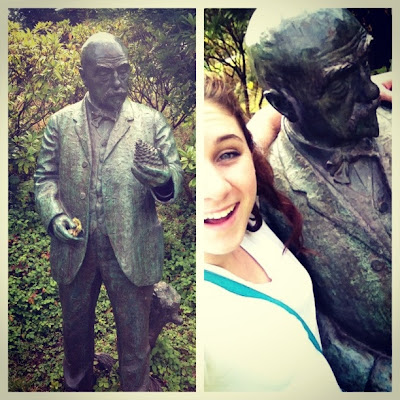Eva Dunn
Professor Stacy Asher
Art 195
September 30, 2012
Golden
Gate Park
Three
miles long, half a mile wide, 1,017 acres, and with a myriad of
activities—Golden Gate Park is 20% larger than Central Park in New York City
and the third most visited park in the United States. This week for my San Francisco Signage class,
I explored Golden Gate Park and the various signs it holds. I was amazed at how many different types of
signs one can find in a place like Golden Gate Park: there are maps, statues,
museum title signs, informational signs, historical signs, and more. It is incredible how important signage was/is
in the development of Golden Gate Park and the development of the museums
within.
One of
the first things I noticed about Golden Gate Park was its massiveness. My first thought when realizing its enormity
was, “How in the world am I going to find everything on the scavenger hunt?” Thank goodness that one really important
aspect of the park is the fact that there are many signs directing tourists,
San Franciscans, or other people (like me) toward the various sights. This allows the park to be accessible and
interactive with the people in it. Don’t
know where something is? There should be
a map close enough. Want to find the de
Young museum? Oh, the map three feet
away might help. Although there are many
directional signs throughout the park, there are also a great amount of
informational ones as well. Several
informational signs include the ones telling about different works of art,
different sculptures, and different historical facts. People not only look at the signs to find
their way, they also read the signs to understand the park, its history, and
the many influential people who contributed to it. Walking around the park last Monday, I
noticed the numerous statues throughout the park, all different donations or
installments that have specific meanings.
What are statues, exactly, and why do they exist? I feel like statues are legacies. People put them there so that they are
remembered or so that the things that were important to them are
remembered. It’s something on the earth
that remains even if someone dies or if something would otherwise be forgotten. Maybe Golden Gate Park, in general, is a
legacy, a statue, a sign installed in San Francisco to help us all remember
nature in the urban city of San Francisco.
Like Ralph Waldo Emerson, a famous transcendentalist author, said, “Adopt
the pace of nature: her secret is patience.”
Nature helps people better see themselves and appreciate life. In an incredibly urban city like San
Francisco, a place like Golden Gate Park is needed to allow for others to
experience nature and the perspective it creates for people.
Although there are many sights and
features in Golden Gate Park, I would like to focus on the different signage
for the two main museums: the Academy of Sciences and the de Young museum. One thing I noticed about the museums was
that they are right across from one another, separated by a beautiful
courtyard. The whole area seems to be
brought together by the courtyard, almost as if the museums are related. Although they both represent different
things, both museums are big attractions in Golden Gate Park and one would
realize this by seeing the extravagant courtyard between them, understanding
the interconnectedness of knowledge and culture. Now, both museums have entirely different
signage. According to Pentagram, the
world’s largest design consultancy, the Academy of Sciences’ logo is very
unique, “Radiating outward from a center oculus, the symbol appears to be
growing—reinforcing the cyclical and dynamic nature of the natural
sciences.” The museum’s signs allow for
form to follow function: the meaning of the logo follows the function of the
museum—to educate the public about the natural sciences. Also outside the Academy of Sciences, several
signs advertise the fairly new Earthquake exhibit inside. Now, the de Young museum’s signage is
entirely different than the Academy of Sciences’. The beautiful wall with the words “de Young”
embossed in the sides stands very large.
Although the sign is massive, the message is subtle; the museum’s title
is part of the building and not particularly eye-catching. However, it is incredibly beautiful, and one
can imagine that the de Young museum would be a more artistic museum than the
Academy of Sciences based off of the signage.
Another very interesting “sign” in front of the de Young museum is Andy
Goldsworthy’s installation entitled “Drawn Stone,” which, according to the sign
describing the work of art, is “inspired by California’s tectonic typography”
and challenges “viewers’ definitions of art by blurring the distinction between
the natural and the man-made, while also accentuating nature’s power to
undermine or destroy even the most monumental works created by humankind.” Although the two different types of signage
are very different, both forms of signage follow the function of the
museums. The Academy of Art’s signage
represents the scientific education one will receive inside and the de Young
museum’s signage represents the artistic education one will receive inside.
Overall, the signage in Golden Gate
Park is very important to the development of the park. The signage is also
crucial to the understanding that people have of the museums within the park. I
will leave you with an important revelation I have had. Every single sign in the world is created to
be seen and recognized. Every sign has a
purpose, just like every person has a purpose.
I guess it’s up to us to define what the purpose is, for signs and for
ourselves.




























































